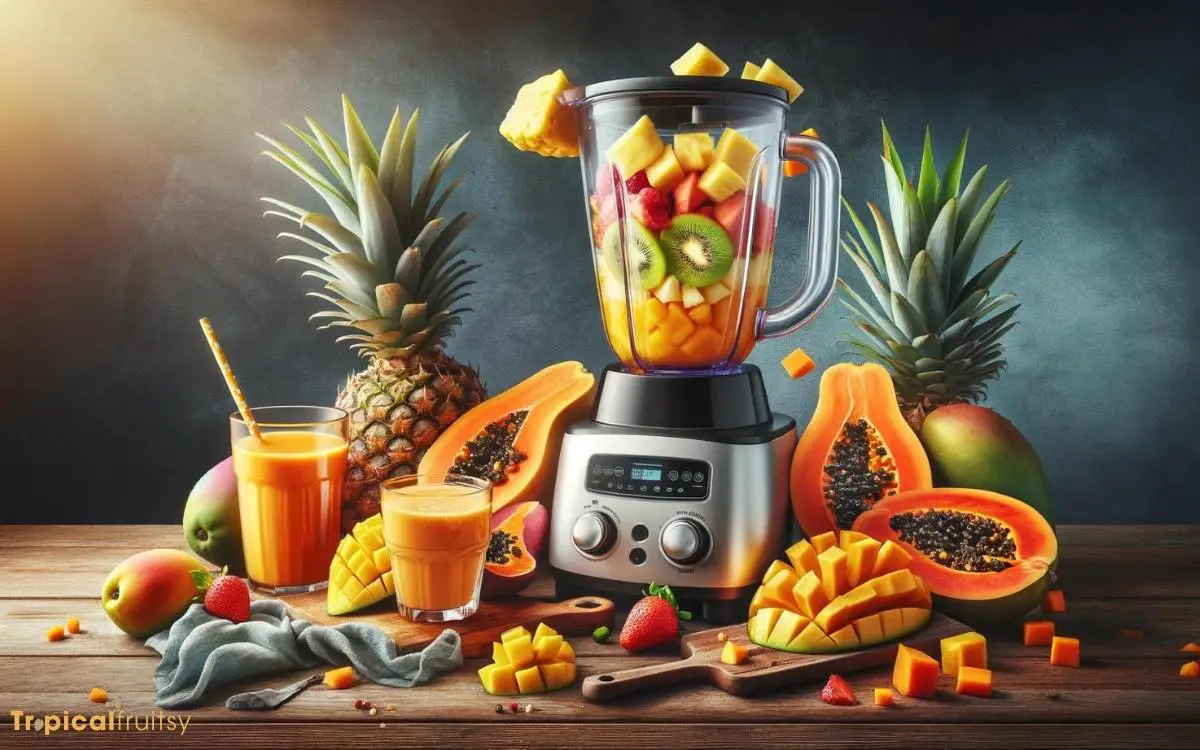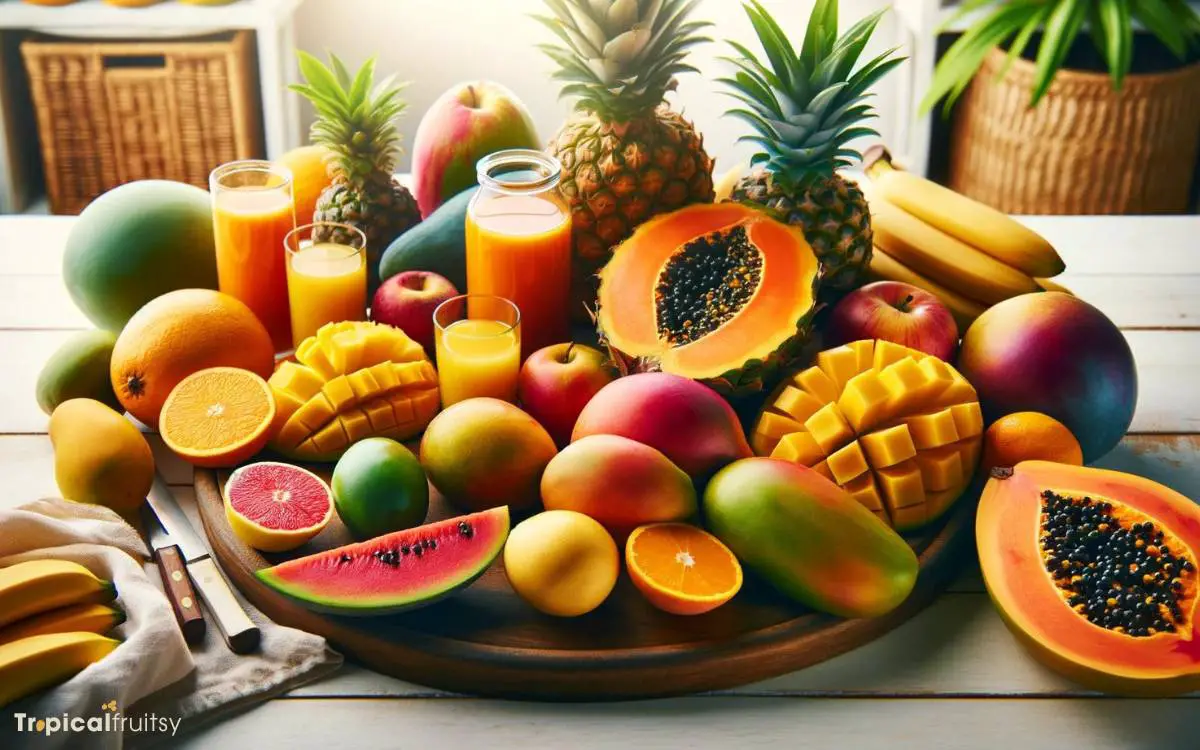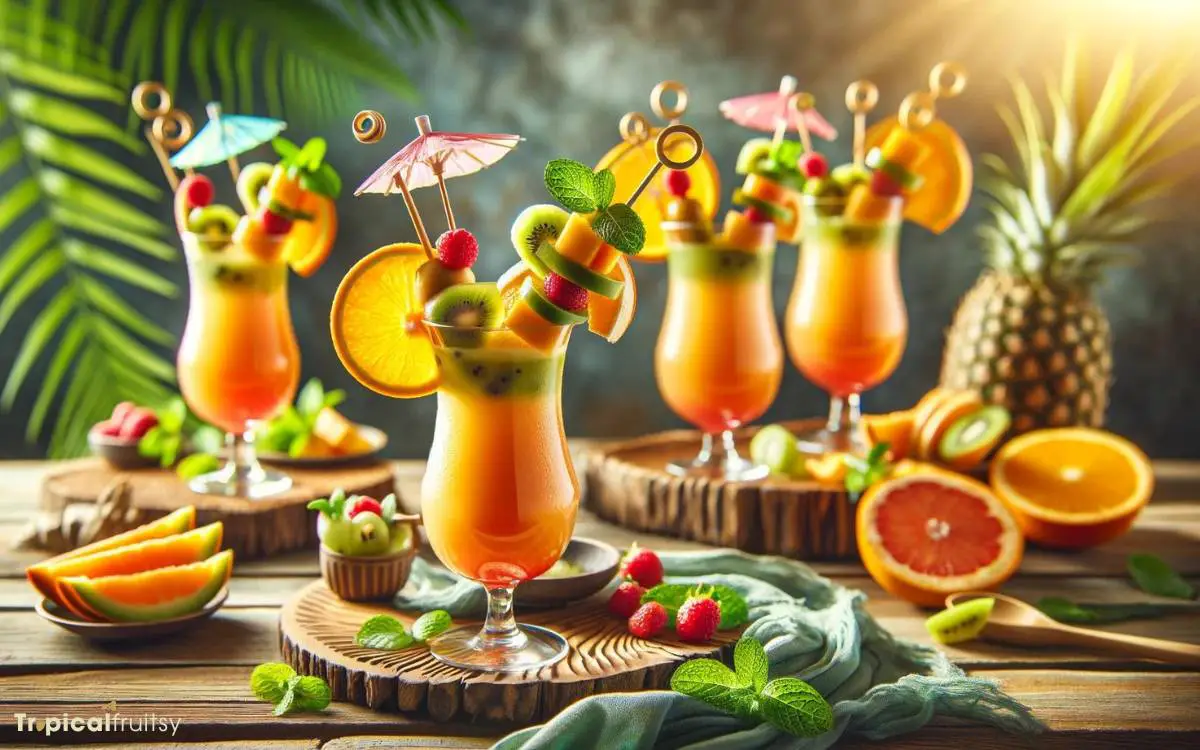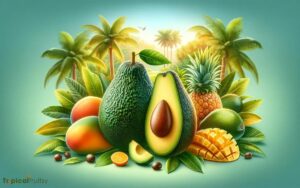How to Make a Tropical Fruit Juice? 3 Easy Steps!
Creating a delectable tropical fruit juice at home is a simple process that involves selecting ripe tropical fruits, cleaning, peeling, and chopping them, and then blending to a desired consistency.
To make a tropical fruit juice, you’ll typically use mangoes, pineapples, papayas, and guavas.
The key to a perfect juice is in the balance of sweet and tangy flavors, and a smooth, well-blended texture. Serve chilled to bring a taste of the tropics to your table.
Here are some quick steps:
For a basic tropical juice, blend 1 ripe mango, 1 cup of pineapple chunks, half a papaya, and 2 peeled guavas until smooth.
Savor the essence of the tropics with a homemade juice blend that’s rich in flavor and packed with vitamins.

Key Takeaway
Step 1: Selecting Your Fruits

Choosing the right combination of ripe, flavorful tropical fruits is essential for creating a delicious and vibrant tropical fruit juice.
An analytical approach to selection involves considering the balance of flavors, where sweetness, acidity, and aroma play pivotal roles.
Evidence suggests that fruits like mangoes and pineapples provide a sweet base, while citrus fruits such as oranges or passion fruit introduce a refreshing acidity that can enhance the overall taste profile.
Additionally, the ripeness of fruit is critical; it affects not just flavor intensity but also the nutritional value, as ripe fruits contain higher levels of antioxidants and vitamins.
For a well-rounded juice, it is imperative to integrate fruits at peak ripeness that complement each other, optimizing the sensory experience and health benefits.
Step 2: Preparing the Ingredients

After selecting a variety of ripe tropical fruits, the next step involves thoroughly washing and cutting them into manageable pieces for juicing. This process is critical for ensuring the quality and safety of your juice.
Here are the steps you should meticulously follow:
- Rinse fruits under cool running water to remove any surface dirt or potential residues.
- Peel the skin off fruits such as mangoes and papayas, as it can be tough and bitter.
- Remove any seeds or pits from fruits like guava and passion fruit to avoid bitterness and enhance texture.
- Cut fruits into smaller chunks to facilitate easier blending and maximize juice extraction.
With the ingredients prepped, we can now focus on the art of blending these tropical delights.
Step 3: Serving and Presentation

How do you elevate your tropical fruit juice from a simple refreshment to an exquisite beverage experience?
Presentation plays a pivotal role in enhancing the overall enjoyment of a drink. Research in the field of sensory perception has shown that visual appeal can significantly affect the taste and enjoyment of food and beverages.
Thus, serving your tropical fruit juice in a clear, high-quality glass adds visual appeal and allows the vibrant colors to stimulate the senses before the first sip is even taken.
Garnishes such as a slice of pineapple or a sprig of mint provide not only decorative flair but also olfactory cues that can enhance the flavor profile. Using chilled glasses can keep the juice refreshing while maintaining the integrity of its taste.
Precision in these details ensures a sophisticated presentation that complements the rich, nuanced flavors of your tropical fruit juice.
Blending Techniques
Begin the blending process by placing the prepared fruit chunks into a high-powered blender for a smooth, even consistency.
To achieve the finest texture, assess the power of the blender and adjust the blending duration accordingly.
Recent studies suggest that pulsing at intervals rather than continuous blending can prevent overheating, which may lead to nutrient degradation.
Moreover, layering softer fruits at the bottom and harder, denser fruits toward the top can facilitate a more efficient blending cycle, reducing the need for excessive liquid and preserving the intensity of the tropical flavors.
The strategic incorporation of ice or cold water not only chills the juice but also contributes to a desirable viscosity.
Next, let us shift our focus to flavor balancing tips, ensuring that the final product tantalizes the palate.
What are the differences between making a tropical fruit juice and a tropical fruit smoothie?
When making a tropical fruit juice, you simply extract the liquid from the fruit. However, a tropical fruit smoothie includes blending the fruit with other ingredients like yogurt or milk. For a delicious tropical fruit smoothie recipe, try combining pineapple, mango, banana, and coconut milk for a creamy treat.
Flavor Balancing Tips
To ensure a harmonious taste profile, one must carefully consider the sweetness, acidity, and bitterness of the selected tropical fruits. Striking the right balance is critical for a satisfying tropical juice.
Here are key considerations:
- Measure Sweetness: Use a refractometer to assess the brix level (sugar content) of the fruit juice, aiming for a consistent sweetness that pleases the palate.
- Adjust Acidity: Analyze the pH level; a range of 3 to 4 is typically ideal for tropical fruit juices, contributing to a fresh and vibrant taste.
- Balance Bitterness: Incorporate a small amount of bitter fruit to add complexity, but ensure it does not overpower the sweetness and acidity.
- Experiment with Ratios: Methodically alter the proportions of each fruit until achieving a balanced, refreshing flavor profile, using sensory analysis to guide adjustments.
Conclusion
The crafting of tropical fruit juice necessitates meticulous selection and preparation of fruits, adept blending techniques, and an understanding of flavor balancing.
The theory that a harmonious blend yields a superior taste experience is corroborated by sensory analysis, which underscores the importance of proportion and synergy in taste perception.
Therefore, a methodical approach not only enhances the aesthetic appeal of the juice but also optimizes its sensory impact, affirming the theory within a culinary context.






